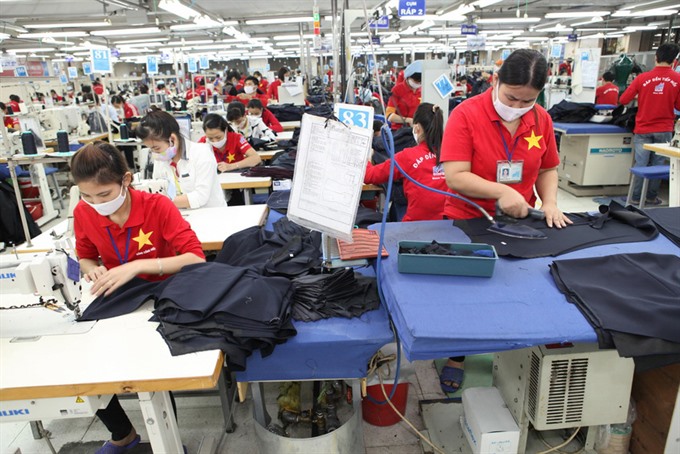 Society
Society

Many enterprises have complained about the Labour Code, which restricts overtime for labourers to 200 hours per year. Many have claimed that the regulation has hampered the development of enterprises and cut income for labourers.
 |
| Under the Labour Code which took effect in 2012, workers in industries like textiles and garments, leather, aquaculture processing, water and electricity supply, drainage and telecommunications, can work a maximum of 300 hours of overtime per year. — VNA/VNS Photo Trần Việt |
HÀ NỘI – Many enterprises have complained about the Labour Code, which restricts overtime for labourers to 200 hours per year. Many have claimed that the regulation has hampered the development of enterprises and cut income for labourers.
The Labour Code, which took effect in 2012, stipulates that a labourer can work a maximum of 200 hours of overtime per year. In fields such as textiles and garments, leather, aquaculture processing, water and electricity supply and drainage and telecommunications, overtime is capped at 300 hours per year.
The regulation aims to protect labourers’ health and curb the abuse of labour.
However, many enterprises said that the regulation was no longer practical.
Nguyễn Xuân Dương, CEO of Hưng Yên Garment Corporation said that employers and employees should be able to negotiate overtime, especially seasonal employees as jobs were only available when enterprises won contracts.
This would help enterprises not violate the law and complete their orders, while labourers could earn more money, he said, adding that Vietnamese labourers working eight hours per day only earn about VNĐ4 million (US$173) per month.
Chu Văn An, deputy director of Minh Phú Aquaculture Corporation said that enterprises had to pay at least 150 per cent of labourers’ wages on week days and up to 300 per cent of wages on holidays. Thus, they only offered overtimes when they had to.
He said that enterprises had a dilemma. During bumper shrimp crops, his corporation could not say no to farmers, but would violate the law if labourers worked too much overtime.
Dương said overtime in Taiwan was 46 hours per month and that in Malaysia was 104 hours per month on average while the average income of labourers reached $40,000 per year. Meanwhile, in Việt Nam, the income was quite modest – about $1,000 per year – but the working extra hours was limited.
Figures from the Việt Nam Labour Federation showed that up to 75.5 per cent of labourers had to work overtime to cover their basic needs.
Nguyễn Thị Hà, a migrant worker at Yên Phong Industrial Zone in northern Bắc Ninh Province said that her official wage was VNĐ5 million ($217) while rent and other expenses cost her VNĐ3 million ($130).
She, and other workers, had to work three to four hours more per day to feed her family in suburban Ba Vì District.
Currently, there were about 30,000 workers, mostly migrants, at the industrial zone.
Workers in other fields are facing the same situation.
Nguyễn Huy, excavator driver for a construction company at Hà Nội’s Võ Chí Công Street said that he was paid to complete his job in a certain time instead of a monthly wage, meaning he had to work at night to finish on time.
Nguyễn Chí Hùng, deputy head of the management board of Hà Nội’s Industrial and Processing Zones said that most enterprises at these zones violated the law on overtime.
Overtime had led to negative impacts. In the first eight months of this year, five strikes occurred at industrial zones as laborers were worked too hard.
According to the Ministry of Labour, Invalids and Social Affairs’ Labour Safety Department, extra working hours would make laborers debilitated. If they work 8 hours a day, they would be able to work for 30-40 years. Meanwhile, if they work too hard, their service length would be 20 years only.
Labourers needed overtime because of their low wages. If their wages were increased, they would likely spend less time working, it said.
Bùi Đức Nhưỡng, deputy head of the department said the department is considering increasing the overtime cap. Overtime limits may be increased to eight hours per week, or about 400 hours per year.
The ministry would carefully consider all elements, including labourers’ health and enterprises’ benefits, before giving the final decision on the increase next month. – VNS